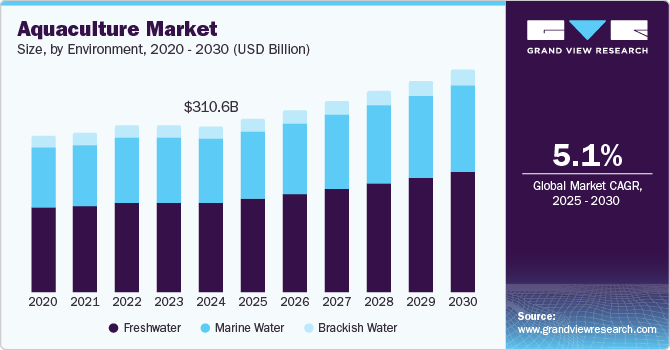Aquaculture Market Trends: Navigating the Future of Sustainable Seafood

The global aquaculture market was valued at approximately USD 310.6 billion in 2024 and is anticipated to grow to USD 417.8 billion by 2030, reflecting a compound annual growth rate (CAGR) of 5.1% from 2025 to 2030. This growth is driven by increased fish consumption, which is supported by rising health awareness and the nutritional advantages of seafood.
Technological advancements in farming practices and a transition towards sustainable aquaculture methods are improving productivity and efficiency. Additionally, the decline in wild fish stocks and evolving dietary preferences are further driving the demand for farmed seafood, particularly in the Asia-Pacific region, which leads the market with its advanced aquaculture techniques and high consumption rates.
Aquaculture, often referred to as aqua farming, involves the cultivation of various aquatic species, including finfish, carp, mollusks, crabs, and aquatic plants. This process includes several interventions in the rearing process, such as regular stocking, feeding, and predator protection, aimed at enhancing productivity. Participants in aquaculture range from small-scale farmers in developing nations to large international corporations. Fish serves as a crucial source of protein and holds significant cultural importance, providing essential nutrients like fatty acids, vitamins, and minerals that support human health.
As the global workforce expands, individuals have less time for home-cooked meals, resulting in a notable increase in dining out. This trend has led to a higher demand for high-protein diets, with more consumers incorporating meat and seafood into their meals. Consequently, both full-service and quick-service restaurants are witnessing a surge in demand for various meats and seafood, which in turn propels the aquaculture industry.
Key Market Trends & Insights
- Asia Pacific aquaculture market dominated the global market and accounted for the largest revenue share of 75.6% in 2024. This growth is attributed to its abundant natural water resources, including rivers, lakes, and coastal areas that create ideal farming conditions.
- The aquaculture sector in the U.S. is expected to grow substantially over the forecast period, owing to technological innovations and strong institutional support. The U.S. government has established policies to promote a competitive and sustainable aquaculture industry, aiming to increase production value significantly by 2025.
- On the basis of fish type, carps, barbels, and other cyprinids led the market and accounted for the largest revenue share of 25.5% in 2024. This growth is attributed to their adaptability to various environmental conditions and high market demand in many regions. In addition, these species are known for their resilience and ability to thrive in diverse water quality, making them suitable for extensive farming practices.
- On the basis of environment, freshwater dominated the market and accounted for the largest revenue share of 54.3% in 2024. This growth is attributed to the widespread availability of freshwater resources, making it accessible in many regions. In addition, freshwater environments such as rivers, lakes, and ponds require simpler management and infrastructure than marine systems.
Order a free sample PDF of the Aquaculture Market Intelligence Study, published by Grand View Research.
Market Size & Forecast
- 2024 Market Size: USD 310.6 Billion
- 2030 Projected Market Size: USD 417.8 Billion
- CAGR (2025-2030): 5.1%
- Asia Pacific: Largest market in 2024
Key Companies & Market Share Insights
Some of the prominent companies in the aquaculture market include Blue Ridge Aquaculture, Cermaq ASA, and Cooke Aquaculture Inc. These firms implement various strategies, such as strategic collaborations, mergers and acquisitions, and new product launches, to enhance their competitive positioning. These approaches collectively enable companies to capture a larger market share and promote sustainable growth.
- Cooke Aquaculture Inc. utilizes vertically integrated aquaculture systems, overseeing every phase from broodstock and juvenile rearing to marine farming and processing. The company is also involved in farming seabass and seabream in Spain, focusing on quality control and sustainability while serving markets across North America, South America, and Europe.
- Eastern Fish Company specializes in the distribution and processing of a diverse array of seafood products. It sources various species from both wild fisheries and aquaculture farms, including shrimp, crab, and fish. The company prioritizes responsible sourcing practices and offers value-added products to meet consumer preferences. With a robust presence in the North American market, Eastern Fish Company serves both retail and food service sectors, ensuring that high-quality seafood reaches customers efficiently.
Key Players
- Blue Ridge Aquaculture
- Cermaq ASA
- Cooke Aquaculture Inc.
- Eastern Fish Co.
- Huon Aquaculture Group Pty Ltd.
- International Fish Farming Co. - Asmak
- RoyMarine Harvest ASA
- Nireus Aquaculture S.A
- Promarisco
- Selonda Aquaculture S.A.
Explore Horizon Databook – The world's most expansive market intelligence platform developed by Grand View Research.
Conclusion
The aquaculture market is poised for significant growth driven by health trends, technological innovations, and changing consumer preferences. As sustainability becomes increasingly important and the demand for seafood rises, the industry is likely to adapt and expand, providing vital nutrition and economic opportunities globally.
- Art
- Causes
- Crafts
- Dance
- Drinks
- Film
- Fitness
- Food
- Games
- Gardening
- Health
- Home
- Literature
- Music
- Networking
- Other
- Party
- Religion
- Shopping
- Sports
- Theater
- Wellness


